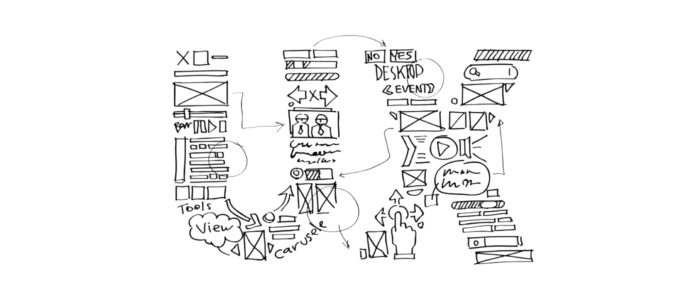“The future of User Experience” is not something I thought I’d ever be writing a blog about. So how did I get here?
The year is 2005. YouTube has just launched (on Valentine’s Day I might add), Prince Charles announced his engagement to Camilla Parker Bowles, but for me, the highlight of the year was launching my career in marketing with my first “proper” role with K2 in London.
Jump 16 years and I’m still in the industry, although now, on the agency side at Digital Noir, Adelaide’s leading digital experience studio.
It’s been three months since I joined the DN Team and I’ve been absolutely blown away by the results that strategic UX design has brought to our clients. Witnessing these results drove my curiosity to discover what we can expect from UX Design in the future, and how businesses can harness the powers of customer-centric design to amplify their brand presence as well as to grow their business.
Digital Noir has been fortunate to attract and retain some of Adelaide’s finest talent in the industry who create beautifully engaging digital experiences for our customers. Our team consists of creative thought leaders, designers and developers who are passionate about creating so much more than “just a website or app”. Taking a holistic approach to digital design and development, our team creates opportunities and solves problems with strategic user experience design that help our clients achieve their business goals.

What is User Experience (UX)?
UX focuses on the interaction a customer has with your product/service, specifically through your digital experience.
Many businesses forget that there is a human on the other side of a website or app. A human with needs that they’re looking to have fulfilled. UX design is anchored to human needs and behaviours and focuses on creating or enhancing a potential customer’s interaction with your brand. I’ve learned that User Experience is not to be confused with the user interface. The interface is the way in which the customer will interface with your brand, the experience, on the other hand, is the ultimate outcome of these interface interactions combined.
Human behaviour and the humans behind digital experiences is something that’s always fascinated me. Digital Noir’s podcast ‘Humans Aren’t Robots’ takes a deep dive into knowing the real people behind the world of digital and offers immense value to listeners who seek to understand humans and how they interact with the digital world around them.
What does the future of UX look like?
Motion design
Website visitors don’t just want to sit and scroll. They want to interact with your website. They want to pinch, swipe, tap, zoom, tilt. Incorporating motion design into the user experience helps keep visitors engaged in your website. The Cool Club is a great example of how motion graphics can bring a website to life, pulling the visitor in to read more to take action.
Voice commands as the primary user interface
When they’re done with pinching, swiping, tapping, zooming and tilting, they’ll want to TALK. Voice commands, instead of touch, are becoming increasingly popular in the UX space. Voice User Interfaces (VUI) help people navigate through a website with minimal effort, using their voice.
Developing a VUI requires strategic planning and intuitive design to anticipate where visitors may prefer to use their voice to engage or instruct the website.
For me, the best thing about VUI is that it gives the visitor the feeling that they are in control of their own experience. There’s nothing worse than visiting a website that just doesn’t do what you want it to do.
Artificial Intelligence (AI)
AI, the simulation of human intelligence through machines, can deliver a lot of value to website visitors. Not to mention the ability to extract meaningful data that can be used in further developing your site or your marketing. AI can process data from hundreds of sources, revealing actionable insights that improve your customer service, marketing and website. Perhaps the most impressive thing about AI data is that it allows you to make predictions about user behaviour. Imagine the opportunities when we can anticipate our customers’ needs and prepare for them? This data can also learn patterns about human behaviour and improve itself according to what it learns, all on its own.
Gestures and Gestural Interfaces
With a heavy focus on content production for SEO, websites are becoming clogged with content that can affect the user’s experience. Gestures help simplify the interface by allowing visitors to remove things that they don’t want there. For example, if there’s a big box of content that’s not of any use to you, you can literally push it off your screen.
Gestures in UX are also set to become the norm empowering visitors to activate parts of a website through gestures.
3D Interfaces
While 3D is nothing new, implementing 3D features in your website is something new-ish. Check out Pluto. I had so much fun playing with this website. The perfect example of how websites can do so much more than just be there.
Device-Agnostic User Interfaces
The increase of wearable devices and multi-device usage requires a UX designer who can create a seamless experience across all devices. Device-agnostic design focuses on creating that seamless experience without additional input from the user.
Accessibility
In all my years in the industry, accessibility is far more prevalent than ever before. Businesses are becoming a lot more socially responsible when it comes to catering for visitors who may have a hearing or visual impairment or disability. Adopting accessibility takes time and planning. But it’s time that is worth taking to create a more inclusive online experience for everyone.
If you’re ready to embrace the possibilities UX design can create for your business, feel free to reach out to me on LinkedIn as I love sharing my learnings as I continue on my journey in the UX design space ✌️


